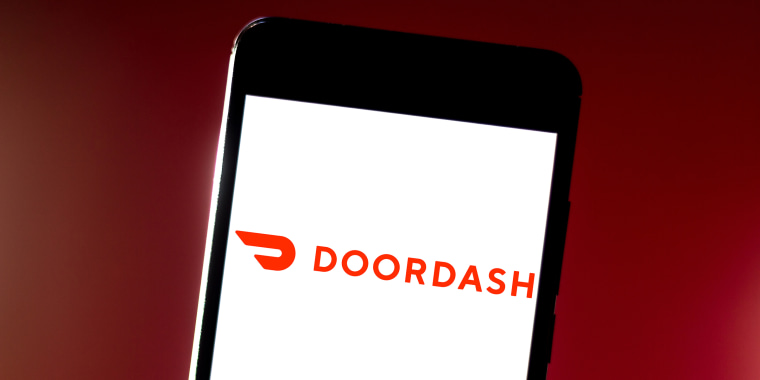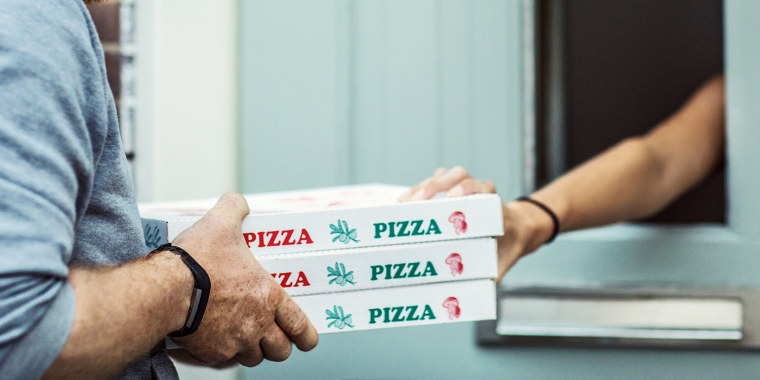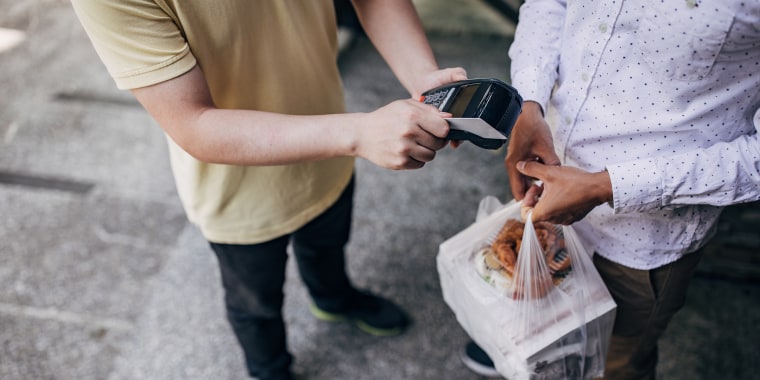For an increasing number of Americans, dining out is no longer an option. Thousands of restaurants across the country have shuttered for business. Even Starbucks, McDonald's and Chick-fil-A have closed their doors to dine-in customers.
However, if you still want to support your favorite pizza place, or if you haven't been able to stock up on groceries yet, ordering in from many places is still an option.
Many independent restaurants are now switching to takeout or delivery-only models due to new city and state rules. More well-known companies, like UberEats and Grubhub, are also making it easier than ever to order takeout amid the ongoing COVID-19 crisis by rolling out no-contact delivery.
But is it actually safe to have someone deliver your food to you?
"I'm still ordering food every day," Dr. Gabriela Andujar Vazquez, a physician who specializes in infectious diseases at Tufts Medical Center, told TODAY. She said she's been so busy lately she wouldn't be eating anything at all if it wasn't for takeout.
Download the TODAY app for the latest coverage on the coronavirus outbreak.
Dr. Adam Splaver, a Florida-based cardiologist and internist agreed, insisting that getting sick via takeout is "not his main concern" when it comes to coronavirus. "According to both the Centers for Disease Control and Prevention and the FDA, there is currently no evidence that the virus can be transmitted via food," he said.
Both doctors, however, have a few tips for providing peace of mind if you're worried about your food delivery, or your delivery person, exposing you to coronavirus.
1. Order from restaurants you trust
As a general rule, stick with restaurants you know and like. If you've ever gotten sick at a place before, or didn't feel comfortable in the dining room, there's no need to push it when it comes to delivery.
"If I don't approve of the cleanliness of their bathroom, I won't eat or order anything from them," Splaver said. If you've never been in a restaurant's bathroom, Splaver recommended reaching out to your local health department for inspection scores. "If the restaurant was good during the pre-coronavirus outbreak, then they are probably good now."
Andujar Vazquez also advised calling up any restaurant you plan on ordering from and asking specific questions about what they're doing to deter the spread of coronavirus at all stages of the cooking and handling process.
2. Order directly from the restaurant when possible
As of last week, many popular delivery services have added no-contact delivery. Still, Splaver would choose an in-house delivery option over a third-party app right now. It might mean that one less person is handling your food and its packaging. It might also help the restaurant stay in business. "Apps take a commission fee which cuts into the profits of the restaurant," he said. "Why not support the restaurant directly during these tough times?"
If you order directly through the restaurant, but they don't offer delivery, try not to pick up your food during peak hours to avoid crowds. Practice social distancing by standing at least 6 feet away from others and wear disposable gloves when picking up your order.
3. Opt for contactless delivery

On third-party apps, choose contactless delivery. Many companies have made this their default setting for the foreseeable future.
When your order arrives, Splaver advises having the person "place the order outside your door and then disinfect the area." Avoid tipping with cash (as virus-causing germs can linger on paper), and opt for tipping through the app.
Before you start eating, examine the individual containers thoroughly to make sure nothing appears as if it's been opened or tampered with. You may also wipe down packaging with a sanitizing wipe. After unpacking your food and handling the packaging, wash your hands thoroughly before digging in. When it comes to the actual food itself, unfortunately if your meal is contaminated with coronavirus, you're not going to be able to see it, Andujar Vazquez said.
4. Get rid of the packaging ASAP

Historically, one of the perks of ordering takeout is being able to just stash the leftovers. That's no longer the case. "You should toss the packaging your food comes in, especially if it's plastic," said Andujar Vazquez. While the hope is that workers are wearing gloves and not coughing or sneezing anywhere near the food they're packing, there's no guarantee. Store any leftovers in clean Tupperware or glass containers you own.
She also believes styrofoam and paper containers could be just as dangerous when it comes to surfaces on which the virus can survive. However, her biggest concern isn't how long a virus can survive. "I'm more concerned with the condition of the person a virus is potentially being transmitted to," she said.
For that reason, she recommends that the elderly or immunosuppressed people would be better off preparing their own food in this climate, especially if they are especially concerned about contracting a virus.
5. Don't share, but do wash your hands before and after
Sharing a pizza that's been cut into slices is OK, but Splaver cautions against eating with others out of the same container, or anywhere else germs can collect. This is true even if the person you're eating with doesn't appear to be sick. Germs can't be seen, but they can be there. "You may be sharing more than just a bite of your food," he warned.
"It's also important to wash you hands before eating and after eating," added Andujar Vazquez.
Worried about putting your delivery person in danger?

Many companies are going to great lengths to protect their delivery people and, without the option to deliver, some restaurants might not be able to survive.
DoorDash, for example, is shipping more than 1 million sets of free hand sanitizer and gloves to its couriers (including Caviar couriers). The company is also providing financial assistance to workers who have been quarantined or diagnosed with COVID-19. A spokesperson for Grubhub said the company has provided all of its drivers with the CDC's guidelines for safe food delivery; Postmates and UberEats are also offering financial relief to impacted drivers.
UberEats is also providing disinfectant wipes and cleaners to as many drivers as it can (given limited supplies) to help keep their cars clean. Last week, Instacart extended paid sick leave to all of its part-time employees in North America.

